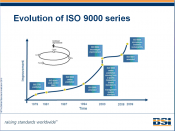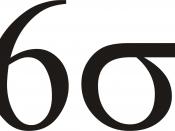Michael Porter was first to create the concept of the value chain in his 1985 book Competitive Advantage: Creating and Sustaining Superior Performance. The main activities of the value chain consist of inbound logistics, operations, outbound logistics, marketing and sales, and service. Successful organizations are able to mesh these activities together thus creating effective and efficient processes in the end-to-end process of the value chain. Two concepts that organizations can implement and use to their advantage are ISO 9000 and Six Sigma. Gaining the required certifications allow organizations to have their management team focus on the impacts to the business in areas such as globalization and outsourcing. Implementing both ISO 9000 and Six Sigma will give the business a greater competitive advantage in the global community and against their competitors. These steps help in identifying the core competencies of the organization and in reducing costs and improving quality along the value chain.
Additionally, organizations can also improve focus on non-value added activities and remove them from activities within the organization.
In taking the steps to reduce costs and improve quality, many organizations are taking the steps towards implementing Six Sigma. The concept behind Six Sigma is to take a disciplined, data-driven approach and use methodology to eliminate defects in any given process. Six standard deviations exist between the mean and nearest specification limit. The concept can be implemented in any type of organization from manufacturing to transactional to service (iSixSigma, 2008).
The primary purpose of Six Sigma is the implementation of measurement-based strategies that focus on improving processes and reducing variances in those processes. How this is achieved is through the use of two Six Sigma sub-methodologies: DMAIC and DMADV (iSixSigma, 2008). DMAIC represents the process of defining, measuring, analyzing, improving, and controlling a given process. DMAIC helps to identify...


